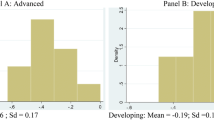Abstract
This paper re-examines the validity of Okun’s Law for 13 selected developed countries over 1970–2013. λ maxand λ trace tests reveal cointegrating relationship between unemployment rate and real GDP growth in all countries except Germany. However, dynamic OLS estimates portray a somewhat different picture. The estimates of bivariate error-correction model (ECM) unveil that Okun’s Law is quite valid only for the USA and South Korea. At the same time, evidence is relatively weaker for Canada, Finland, France, Japan, Italy, The Netherlands, New Zealand, Sweden, UK and Australia. However, it is invalid for Germany.
Similar content being viewed by others
References
Akaike, H. (1969). “Fitting autoregression for prediction”. Ann Inst Stat Math, 21, 243–247.
Altig D, Fitzgerald T, Rupert P (1997) “Okun’s law revisited: should we worry about low employment?”, Federal Reserve Bank of Cleveland, Economic Commentary, 1-4. Retrieved from http://proxy1.libraray.in.edu.hk:2197/docview/2336084458?accountid=12107
Artha IKDS, Haan JD (2011) Market flexibility and the impact of the financial crisis. Kyklos 64:213–230
Attfield CLF, Silverstone B (1997) Okun’s coefficient: a comment. Review of Economics and Statistics 70(2):326–329
Bankole AS, Fatai BO (2013) Empirical test of okun’s law in Nigeria. International Journal of Economic Practices and Theories 3:337–231
Beaton, K. (2010). “Time variation in Okun’s Law: A Canada and U.S. comparison”, Bank of Canada Working Paper No. 2010–7, Bank of Canada, www.bankofcanada.ca/wp-content/uploads/2010/05/wp10-7.pdf
Burgen E, Meyer B, Tasci M (2012) An elusive relation between unemployment and GDP growth: okun’s law. Federal Reserve Bank of Cleveland Retrieved from http://www.clevelandfed.org/research/trends/2012/0412/011abmar.cfm
Cevik EI, Dibooglu S, Barisik S (2013) Asymmetry in the unemployment-output relationship over the business cycle: evidence from transition economies. Comp Econ Stud 55:557–581
Chamberlin G (2011) Okun’s law revisited. Economic and Labor Market Review 5(2):104–132 Retrieved from http://proxy1.libraray.in.edu.hk:2197/docview/857921570?accountid=12107
Connaughton J, Madsen R (2009) Regional implications of the 2001 recession. Ann Reg Sci 43:491–507
Connaughton J, Madsen R (2012) US state and regional economic impact of the 2008/2009 recession. Journal of Regional Analysis and Policy 42:177–187
Daly, Mary, and Hobijn, B. (2010). “Okun’s Law and the unemployment surprise of 2009″, Federal Reserve Bank of San Francisco, Economic Letter, No. 2010–7, www.frbsf.org/publications/economics/letter/2010/el2010-07.html
Engle RF, Granger CWJ (1987) Cointegration and error-correction: representation, estimation, and testing. Econometrica 55:251–276
Granger CWJ, Newbold P (1974) Spurious regressions in econometrics. J Econ 2:111–120
Irfan, L., Muhammad, S., and Jalil, M. (2012). “Test of okun’s law in some Asian countries: cointegration approach”. Retrieved from http://dx.doi.org/10.2139/ssrn.1562602
Johansen S (1988) Statistical analysis of cointegration vectors. J Econ Dyn Control 12:231–254
Johansen S (1992) Testing structural hypothesis in multivariate cointegration analysis of the PPP and the VIP for U.K. J Econ 53:211–244
Johansen S (1995) Likelihood-based inference in cointegrated vector autoregressive models. Oxford University Press, Oxford
Johansen S, Juselius K (1990) Maximum likelihood estimation and inference on cointegration with applications to the demand for money. Oxf Bull Econ Stat 51:169–210
Karfakis C, Katralidis C, Tsanana E (2014) Does output predict unemployment? A look at okun’s law in Greece. Int Labour Rev 153:421–433
Kitov I, Kitov O (2012) Modeling unemployment and employment in advanced economics: okun’s law with a structural break. Theoretical and Practical Research in Economic Fields 3(1):26–41 Retrieved from http://proxy1.libraray.in.edu.hk:2197/docview/1038147682?accountid=12107
Knotek, Edward S. II (2007). “How useful is Okun’s Law?”. Federal Reserve Bank of Kansas City, Economic Review, Fourth Quarter, 73–103, www.kc.frb.org/publicat/econrev/PDF/4q07Knotek.pdf
Kwiatkowski D, Phillips PCB, Schmidt P, Shin Y (1992) Testing the null hypothesis of stationarity against the alternative of a unit root. J Econ 54:159–178
Lütkepohl H, Saikkonen P, Trenkler C (2001) Maximum Eigen value versus trace tests for the cointegrating rank of a VAR process. Econometrics Journal 4:287–310
Neely C (2010) Okun’s law: output and unemployment. Federal Reserve Bank of St. Louis Retrieved from http://research.stlouisfed.org/publications/es/10/ES1004.pdf
Ng S, Perron P (2001) Lag length selection and the construction of unit root tests with good size and power. Econometrica 64:813–836
Okun, A. M. (1962). “Potential GNP: Its measurement and significance”. Proceedings of the Business and Economic Statistics Section of the American Statistical Association. 89–104.
Owyang M, Sekhposyan T (2012) Okun’s law over the business cycle: was the recession really that different? Federal Reserve Bank of St. Louis Retrieved from http://research.stlouisfed.org/publications/review/12/09/399-418Owyang_rev.pdf
Phillips PCB (1986) Understanding spurious regressions in econometrics. J Econ 33:311–340
Phillips PCB, Hansen BE (1990) Statistical inference in instrumental variables regression with I(1) processes. Review of Economic Studies 57:99–125
Plosser CI, Schwert GW (1979) Potential GNP: its measurement and significance: a dissenting opinion. Carn-Roch Conf Ser Public Policy 10(1):179–186
Solow RM (1997) “What is labor market flexibility: what is it good for?”. Proceedings of the British Academy 97:189–211
Songer L, Stiassny A (2002) An analysis on the structural stability of okun’s law- a cross country study. Appl Econ 14(34):1775–1787
Spence M, Warsh AK (2015) “The fed has hurt business investment”. Wall Street J, Retrieved from http://www.wsj.com/articles/the-fed-has-hurt-business-investment-1445899627
Stock JH, Watson M (1993) A simple estimator of cointegrating vectors in higher order integrated systems. Econometrica 61:783–820
Wen Y, Chen M (2012) “Okun’s law: a meaningful guide for monetary policy?”, federal reserve bank of St. Louis Retrieved from http://research.stlouisfed.org/publications/es/12/ES_2012-06-08.pdf
Author information
Authors and Affiliations
Corresponding author
Appendix
Appendix
(Derivation of Growth Rate Form of Okun’s Law).
In its original form, Okun’s Law is:
Where, U is the unemployment rate, Y is real GDP, U* is natural rate of unemployment, Y* is potential real GDP and θ is the Okun’s coefficient.
To derive the growth rate revision, equation (4) is expanded as follows:
Totally differentiating equation (5) and assuming Y* constant at full employment, with respect to all variables,
For simplification, if the natural rate of unemployment is unchanged, dU* = 0. Now, rearranging the terms,
Usually, Y will be close to Y* in the long run – within a few percent, at least. Therefore, dY/Y* can be approximated by dY/Y, the growth rate of GDP. Finally, in growth rate version,
Rights and permissions
About this article
Cite this article
Rahman, M., Mustafa, M. Okun’s law: evidence of 13 selected developed countries. J Econ Finan 41, 297–310 (2017). https://doi.org/10.1007/s12197-015-9351-5
Published:
Issue Date:
DOI: https://doi.org/10.1007/s12197-015-9351-5




